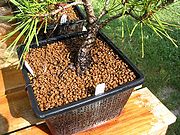
Akadama
Encyclopedia
is a naturally occurring, granular clay
like mineral that is used as soil
for bonsai trees and other container-grown plants. It is surface mined, immediately sifted and bagged, and supplied in various grades: the deeper mined grade being somewhat harder and more useful in horticulture than the more shallow mined grades. Akadama may also act as one component of growing medium when combined with other elements such as sand, composted bark, peat, or crushed lava. Akadama’s colour darkens when moist which can help the grower determine when to water a tree.
While Akadama is more costly than alternative soil components, it is prized by many growers for its ability to retain water and nutrients while still providing porosity and free drainage
. For all of its qualities, many bonsai growers consider the cost of akadama prohibitive or unnecessary. Still other growers claim that when subjected to cold and wet climates the granules progressively break down into smaller particles which inhibit drainage, which is an essential characteristic of bonsai soil. This problem can be avoided either by incorporating sand or grit in the soil mix, or by using the deeper-mined, harder grades.
The product manufactured in the United States called Turface, most often used as a soil amendment and for surface dressing of baseball infields, is often erroneously thought to be a similar material. However, it bears no similarity to Akadama.
Akadama is also a Japanese port wine created in 1907 by Shinjiro Torii, founder of Suntory
. The yellow label bears a predominate red "meat ball".


Clay
Clay is a general term including many combinations of one or more clay minerals with traces of metal oxides and organic matter. Geologic clay deposits are mostly composed of phyllosilicate minerals containing variable amounts of water trapped in the mineral structure.- Formation :Clay minerals...
like mineral that is used as soil
Soil
Soil is a natural body consisting of layers of mineral constituents of variable thicknesses, which differ from the parent materials in their morphological, physical, chemical, and mineralogical characteristics...
for bonsai trees and other container-grown plants. It is surface mined, immediately sifted and bagged, and supplied in various grades: the deeper mined grade being somewhat harder and more useful in horticulture than the more shallow mined grades. Akadama may also act as one component of growing medium when combined with other elements such as sand, composted bark, peat, or crushed lava. Akadama’s colour darkens when moist which can help the grower determine when to water a tree.
While Akadama is more costly than alternative soil components, it is prized by many growers for its ability to retain water and nutrients while still providing porosity and free drainage
Drainage
Drainage is the natural or artificial removal of surface and sub-surface water from an area. Many agricultural soils need drainage to improve production or to manage water supplies.-Early history:...
. For all of its qualities, many bonsai growers consider the cost of akadama prohibitive or unnecessary. Still other growers claim that when subjected to cold and wet climates the granules progressively break down into smaller particles which inhibit drainage, which is an essential characteristic of bonsai soil. This problem can be avoided either by incorporating sand or grit in the soil mix, or by using the deeper-mined, harder grades.
The product manufactured in the United States called Turface, most often used as a soil amendment and for surface dressing of baseball infields, is often erroneously thought to be a similar material. However, it bears no similarity to Akadama.
Akadama is also a Japanese port wine created in 1907 by Shinjiro Torii, founder of Suntory
Suntory
is a Japanese brewing and distilling company group. Established in 1899, it is one of the oldest companies in the distribution of alcoholic beverages in Japan. Its business has expanded to other fields, and the company now offers everything from soft drinks to sandwich chains...
. The yellow label bears a predominate red "meat ball".



